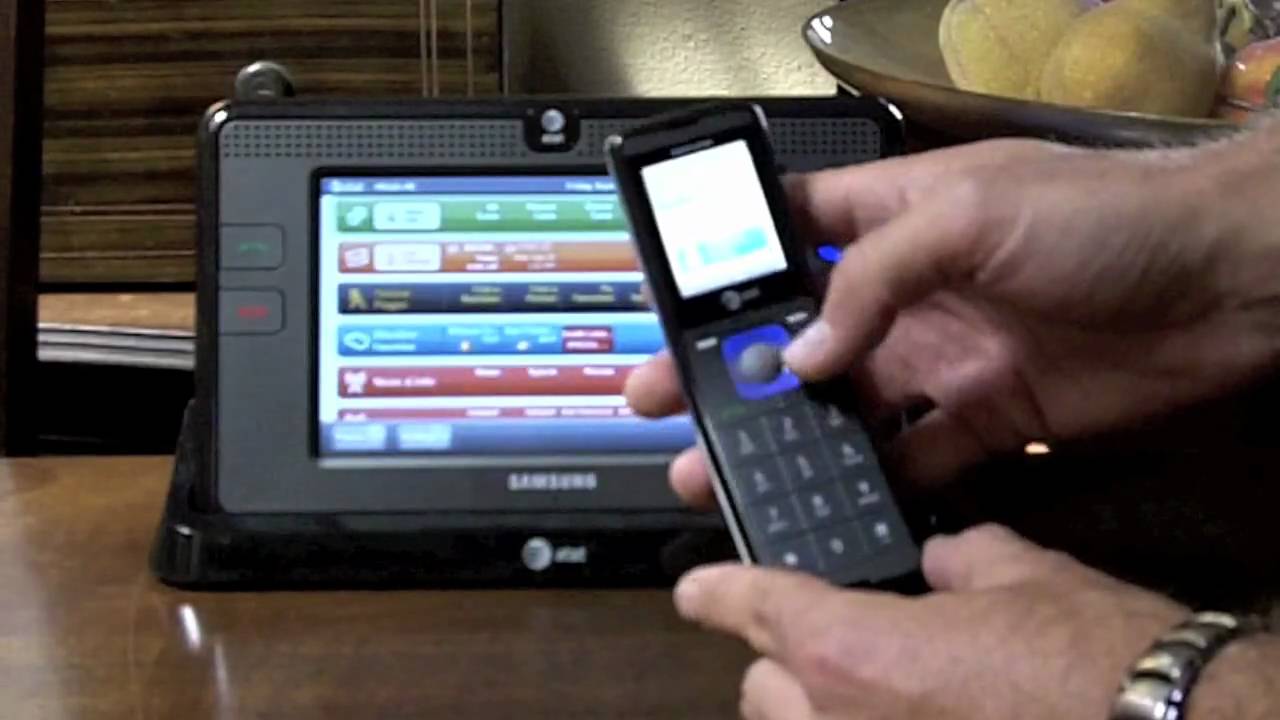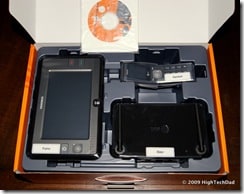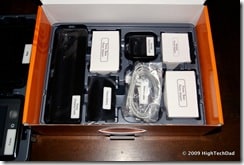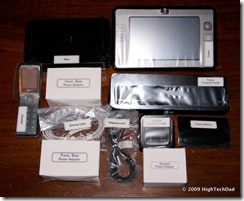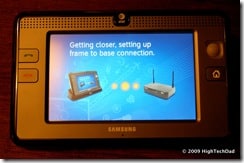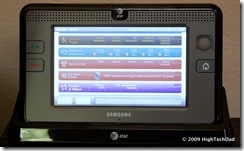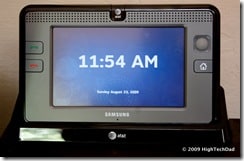There is a niche out there between the techno-savvy and technophobes. It’s a market where the members see the value in technology and gadgets but might not adopt it quickly or readily. They may have a computer or laptop but only use it periodically to pay bills, check news or weather or do email. If they have kids, their kids are probably much more into tech than they are.
So how do you sell technology to this niche? Not very easily. The problem is, they would probably like to spend their money and time elsewhere than with a gadget. The reason I bring this subject up is because I think AT&T’s HomeManager might be a product that falls into this Bermuda Triangle of technology positioning.
Don’t get me wrong though, the concept behind the HomeManager is really great (and the $99 special price point – originally it cost $299.99 – isn’t bad either – note there are some qualifications you must meet in order to get that price). The HomeManager is essentially a wireless touch screen tablet that has core “family useful†functionality but is basically limited to a pre-defined set of functionality. In my opinion, AT&T has a bit of a slippery slope to climb in order to make the product truly attractive to a wider audience than simply the niche described above. My family, obviously bolstered by an incredible amount of tech, easily integrated it into our gadget mix. Even my 10 year old daughter uses the HomeManager to quickly check weather forecasts so that she knows what to wear that day. I use it for weather, sports and quickly scanning the visual voicemail. I’m trying to train my wife on using it to check local movie theater playtimes. The problem is, much of this information is already available to us on a variety of other devices (e.g., laptops and cell phones or on TV).
But what about those families who don’t have as many connected devices as we do? Well, the HomeManager might play well there as well as, potentially with “seasoned” citizen households (assuming a tech-savvy family member or friend can help them set it up). Target market aside, let’s dive into what the HomeManager is and does.
About the HomeManager
As I briefly mentioned, the HomeManager is an internet-connected device that consists of three components: a transmitter, a touch-screen frame and a handheld phone. Each of these devices work together well, have a consistent look and feel and seem to be quite well built (the manufacturer is Samsung).
First and foremost, I do have to admit that the packaging was extremely well done. I received mine a few months ago and took the following unboxing shots. Every item in the box, down to the various cords, were clearly labeled. This is critical to ensure that all types of customers who receive the HomeManager, tech savvy or not, have no confusion about what each part is used for.
The transmitter
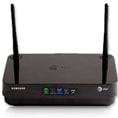
The transmitter uses a secure and proprietary wireless frequency to send internet and phone traffic. I’m not sure if it causes or is affected by other wireless networks or frequencies though.
The handset

The handset will synchronize any contacts that you have set up within the frame. It also provides access to Visual Voicemail and a call history.
The frame

The frame has a full duplex speakerphone which actually, when cranked up, has quite a good volume for conference or regular phone calls. You use the speaker to playback voicemails or see movie previews, for example. In order to use it, you must have a broadband connection (e.g., through AT&T) with a minimum download speed of 768 Kbs (the documentation says that the recommended download speed is 1.5 Mbps which I do recommend especially if you are using the richer internet features a lot). You also obviously need telephone service which can be either a POTS (Plain Old Telephone Service) or VoIP (Voice over IP). You will need to have the appropriate DSL filters on your phoneline and must use one with the HomeManager.
The Setup
As I mentioned, all of the items that come in the box are incredibly well labeled. It’s hard to not know what everything is used for. This makes for an easy setup, or so I thought.
I had to move some things around and locate a spare Ethernet switch so that I had a port to plug into the back of the transmitter. Once I did that and connected the phone line and power, plugged in the power for the base of the frame and the base of the handset, I was off and running. Everything seemed just a bit too easy. For most people, I believe that the setup is, actually, very easy. Unfortunately (and to this day, I’m still not sure why – perhaps interference or a band antenna), I had a bit of trouble. Here’s what happened.
I had the transmitter on the top of a shelf and the frame & base about 10 feet away at a slightly lower level. When you power on the frame (and note that it is important that you have the transmitter up and running first), it will search for a signal from the transmitter automatically. Also, you must allow the transmitter to have an IP address assigned to it dynamically for it to work its wonders. Once the frame powers up, you will see a screen similar to this one:
Unfortunately for me, I could not get an Internet connection while the frame was sitting in the charging base (the phone part worked fine though). When the frame senses that it can’t get an Internet connection, it asks you if you want to simply use the telephone feature. I was able to use the telephone and get a solid dialtone throughout my house. Also, if I put my frame right next to the transmitter, removed the battery and re-inserted it, I was able to establish a connection with the Internet. However, once I put it back in the base, it would disconnect, thus removing 90% of the useful functionality of the HomeManager. After I talked to a very friendly AT&T HomeManager support person, I found out that the frame MUST have internet connectivity while it is in the charging base for it to receive software and firmware updates. At this point, I was not in good shape.
So, reluctantly, I decided to find an alternate location for the transmitter, one that was closer to the frame and charging base (about 5 feet away from each other and in direct site). Once I “rewired†my setup (luckily I had some 30 ft. Ethernet and phone cords in my box of saved cables under my desk), I was able to get an Internet connection while the frame was in the charger. Do note, that it took me a while to troubleshoot this. I really do recommend that you do a test in the locations where you want the devices before you hide wires or finalize your setup.
Once you have Internet connectivity, there are some other things that you can configure. For starters, you should set you home address. I can’t remember if it pre-populates based on your home phone. The address is used to with the Yellow Pages section so that it can locate businesses close to you. Another good thing to set up is your voicemail. You have the option to leave your voice with the “traditional†option or to use a (better) Visual Voicemail, similar to what you can get on the iPhone or the BlackBerry Bold (or other devices). Visual Voicemail lets you see and pick the message you want to hear from anywhere in the message queue. For example, if you have 5 messages and you want to listen to the 4th one, you simply click on it and it plays; you don’t have to listen to all of the other messages before it. I, obviously, went with this option. Note: HomeManager customers who subscribe to AT&T’s Unified Messaging in some states (see the site for details) can get the Unified Messaging service at no charge (I think it saves you about $10 a month!).
Also, when I first signed up, there was a feature that let you sync your contacts from a supported cell phone. I thought my wife would be excited to have this since she is the one who is on the phone much more frequently than I am, arranging our crazy family schedule. So, I configured AT&T’s Mobile Backup Service (which is waived with the HomeManager) to have her address book copied over. I was astounded to find out that during the week or two that I was working on configuring the device (on and off), AT&T SUSPENDED this feature indefinitely. I have asked both their PR firm and some technical people if it will be reinstated or replaced with something else and they did not know. I found this to be a big disappointment. And actually, the Calendar and Contracts are now only stand-alone features within the frame. You have no way of importing or syncing them with other devices (apart from the contact sync between the frame and the handset). In my opinion, this is where all effort should be placed to really make this product useful. It must be able to sync with one address book and calendar either located on a Mac or PC or cell phone to make it really viable as an essential home appliance. I do expect this will change in the future.
Don’t get me wrong though, there are plenty of other features that make this device worthwhile.
Features & Usage
Before I go into some of the details of the HomeManager, I recommend you watch my quick video review:
Obviously I can’t cover all of the functionality in a 5 minute video, but it should give you an idea of some of the main features and benefits. The important thing to realize about this device is that it is quite customizable. In most of the different categories (which display as colored bars), you can set up favorites (e.g., sports teams, movie theaters, weather cities, news and entertainment, etc.). I haven’t tested if there is a limit to the number of bars you might have but I’m sure some exist. You can set up multiple email account and have different address books.
Having a touch screen makes the device very useful. You can use your finger or an included stylus (which is conveniently hidden on the side/back of the frame – I only just discovered it). There is also a round button that pulses a blue light when there is a voicemail or a solid blue when the line is in use. This button is used to scroll down the various color bars/categories. Once you find the category you want, you simply click on it and drill into some of the other features within.
There is a handy screensaver as well. The picture below shows the clock mode but there are several others including: Picture Frame, Weather, Top Stories, Sports Scores, Stock Quotes and Analog Clock. My only complaint about the screensaver mode is that it is always on and really lights up the room (especially if it is in your bedroom). I haven’t tried the “None†setting because I like seeing the clock. However, Weather might be the most useful.
Another minor complaint that I have is the placement of the physical “off-hook†button. It is in a location where I frequently grab the phone, suddenly launching it into speakerphone mode. I may have moved them slightly lower down the left side since when you grab with the left hand, your thumb lands right on the green button. Minor but I have done it so frequently, I felt it should be mentioned.
Some other highlights that I should “call†out:
- Call history – there is a detailed call history on the frame and handset. You can easily add callers to the Address book and fill out full contact information including a picture.
- Alarms & Timer – You can set up alarms, timers and Calendar notifications to remind you of important events and items.
- Yellow Pages – this is an extremely handy replacement for those large physical phonebooks. Get full contact information and even a map on many people and businesses if an address is available.
- Customizations – you can get recipes, localized weather, horoscopes, lottery numbers, news (I wish it had local news but it doesn’t), sports scores, stock quotes and lottery numbers quickly and easily.
If you can, I recommend going and trying the HomeManager out at a local AT&T store.
Summary
Despite the fact that I pulled the hair out of my head during the initial setup where I spent countless hours trying to get the darn frame to connect while it was sitting in the base, once everything was up and running properly, I actually found myself quite pleased with this device. As I mentioned at the beginning of this review, there is a rather small target audience who might really find this device useful. I think that if AT&T could integrate it in with a full cell phone sync (of contacts & calendars), it would make it even more desirable by a busy family. While it is NOT a laptop or computer replacement, it can potentially be a communication hub for a family. The features are useful and I am personally starting to integrate it more into our daily gadgetry use.
There is a lot of potential for AT&T to take the HomeManager much farther. I would like to see, as I mentioned, localized news, more robust syncing, some social media integration (e.g., Facebook, MySpace and Twitter accounts that are fully interactive), video and audio podcast subscriptions, RSS feeds and perhaps in a future version, the inclusion of a webcam to allow for video conferencing. At the $99 price point, its a pretty good deal (but remember that you have to have AT&T to fully take advantage of all of the features.
Note: AT&T and their PR firm have graciously allowed me to keep the HomeManager prior to this review. More information on my Product Review policies can be seen in my About page.
HTD says: The AT&T HomeManager is a good first step to a unified family communication device that provides helpful functionality and information in a busy family lifestyle.
